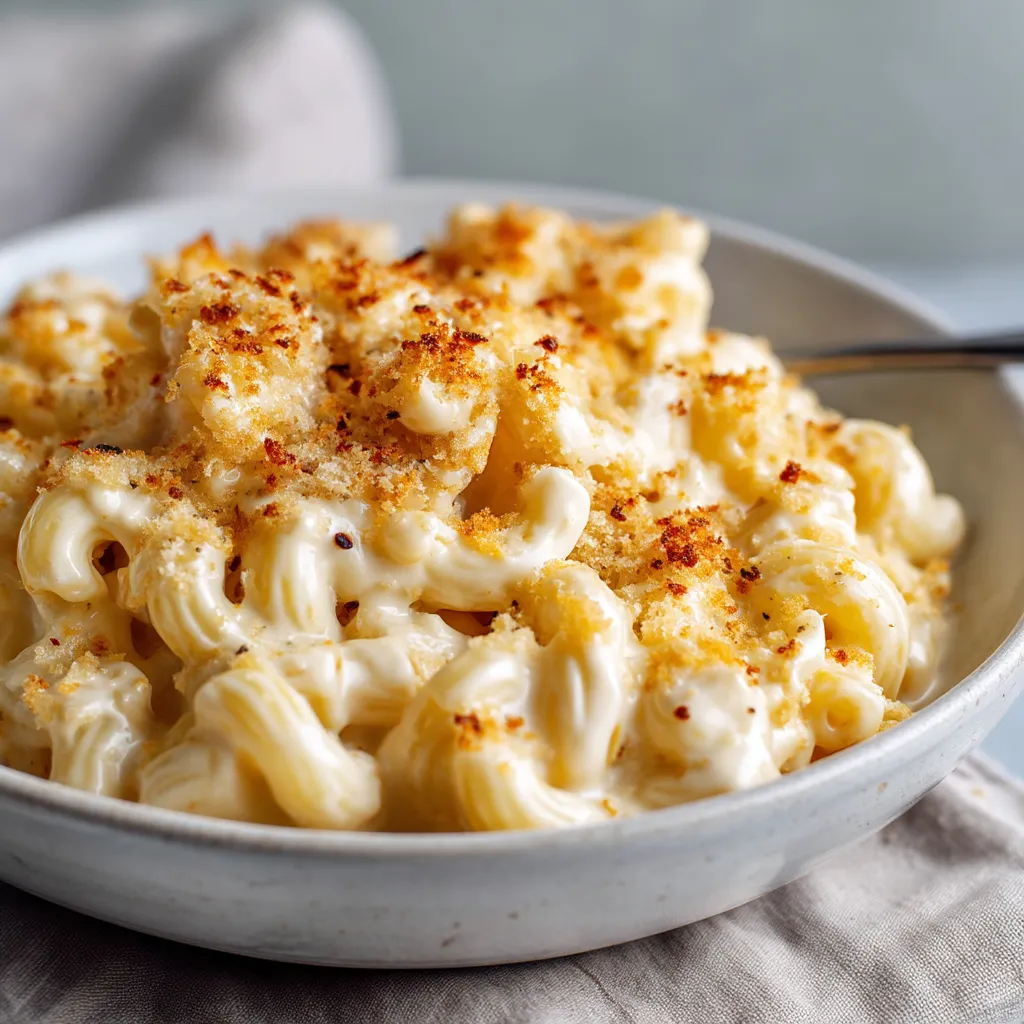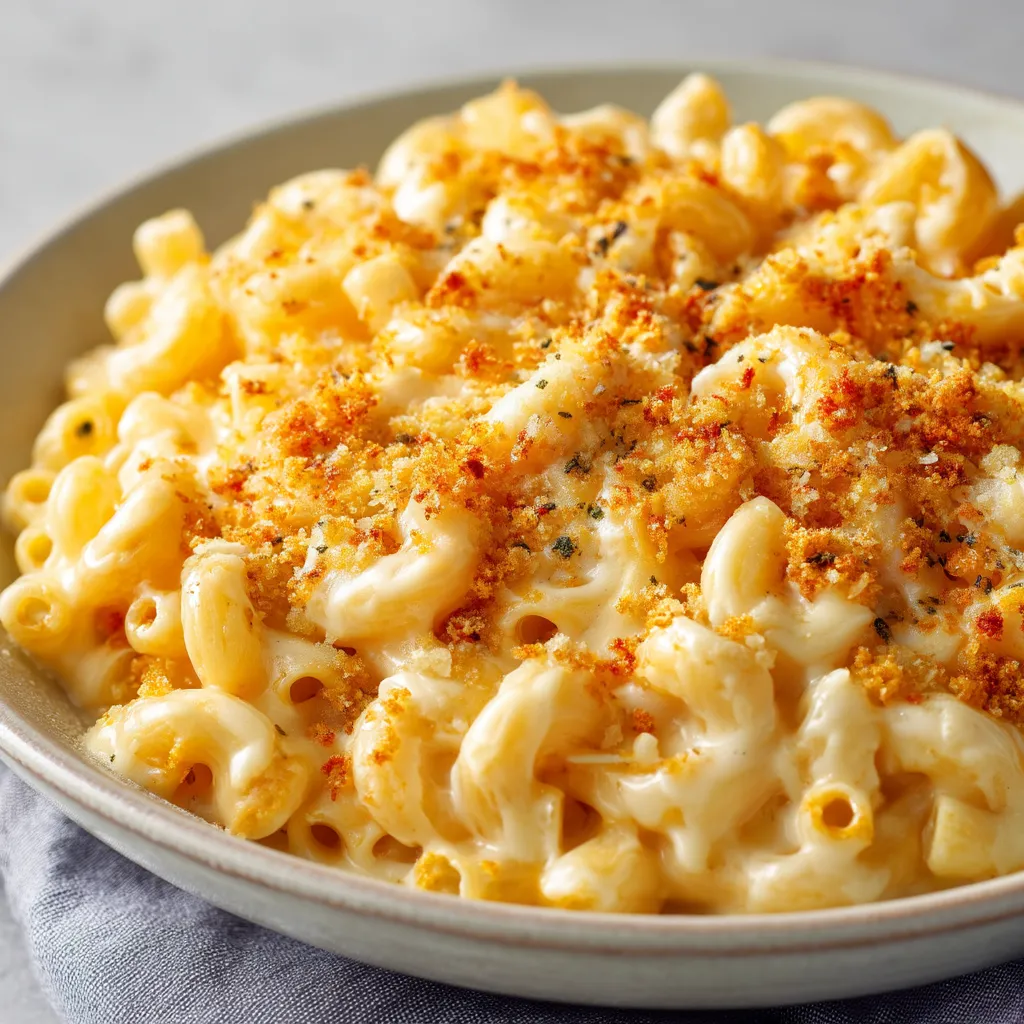 Save It
Save It This creamy cheddar mac and cheese delivers the ultimate comfort food experience with its silky sauce and perfectly cooked pasta. I've perfected this recipe over years of Sunday family dinners, making it my go-to when nothing but pure comfort will do.
I first made this mac and cheese when my daughter was going through a picky eating phase. It became the one dish she would always clean her plate for, and now it's our special tradition whenever someone needs a bit of comfort food therapy.
Ingredients
- Elbow macaroni: The classic choice for mac and cheese with perfect sauce-catching ridges
- Unsalted butter: Creates the foundation for our roux and adds richness
- All-purpose flour: Works with butter to thicken our sauce beautifully
- Whole milk: For maximum creaminess use whole milk nothing less
- Sharp cheddar cheese: Provides that distinctive flavor always grate it yourself for best melting
- Cream cheese: The secret ingredient that makes this mac and cheese extra velvety
- Dijon mustard: Enhances the cheese flavor without making it taste mustardy
- Salt and freshly ground black pepper: These basics bring all the flavors together
- Optional spices: Garlic powder or cayenne pepper add subtle depth
Step-by-Step Instructions
- Cook the Pasta:
- Bring a large pot of generously salted water to a rolling boil. Add your macaroni and cook until just al dente, usually 1 minute less than package directions suggest. The pasta will continue cooking in the sauce, so keeping it slightly firm now prevents mushiness later. Reserve a small cup of pasta water before draining, as it can help adjust sauce consistency if needed.
- Create the Roux:
- In a medium saucepan over medium heat, melt butter completely until it starts to foam but before it browns. Add the flour and whisk continuously for a full minute. This cooking process eliminates the raw flour taste and creates the thickening base for your sauce. The mixture should look like wet sand and smell slightly nutty.
- Develop the Sauce:
- While continuing to whisk, slowly stream in warm milk in small additions, fully incorporating each before adding more. This gradual approach prevents lumps from forming. Keep whisking as the mixture comes to a gentle simmer, cooking for 4-5 minutes until noticeably thickened. You should be able to draw a line on the back of a spoon that holds its shape.
- Add the Cheese:
- Reduce the heat to low to prevent the cheese from becoming grainy. Add handfuls of shredded cheddar gradually, stirring until each addition is fully melted before adding more. Then incorporate the cream cheese in small pieces, stirring until completely smooth. Add Dijon mustard, salt, pepper, and any optional spices, tasting and adjusting seasonings as needed.
- Combine with Pasta:
- Fold the drained pasta directly into the cheese sauce, stirring gently but thoroughly to ensure every piece is coated evenly. If the mixture seems too thick, add a splash of the reserved pasta water to reach your desired consistency. Allow the pasta to sit in the sauce for about 2 minutes to absorb some of the flavors.
 Save It
Save It The cream cheese in this recipe is my absolute favorite ingredient trick. I discovered it by accident when I ran short on cheddar one night and needed to stretch my sauce. The result was so much silkier than my traditional recipe that it's become non-negotiable in every batch since. My husband now claims he can tell immediately if I've skipped this secret ingredient.
Make Ahead and Storage
This mac and cheese reheats beautifully, making it perfect for meal prep. Store leftovers in an airtight container in the refrigerator for up to 4 days. When reheating, add a splash of milk and stir frequently to restore the creamy texture. The sauce naturally thickens when cold, so don't be alarmed if it seems solid straight from the refrigerator.
Perfect Pairings
Balance the richness of this mac and cheese with something acidic or fresh. A simple green salad dressed with vinaigrette provides the perfect contrast to the creamy pasta. For beverages, try a crisp white wine like Sauvignon Blanc or a hoppy IPA that can cut through the richness. I always serve this with some roasted broccoli on the side, as the slightly charred vegetables complement the cheese sauce wonderfully.
Variations Worth Trying
Transform this classic into countless variations by adding mix-ins before the final serving. For protein, fold in crispy bacon pieces, shredded rotisserie chicken, or sautéed mushrooms. Veggie additions like roasted butternut squash, steamed broccoli, or caramelized onions add both nutrition and flavor complexity. For a truly decadent version, try using half Gruyère and half cheddar with a sprinkle of truffle oil for special occasions.
 Save It
Save It Common Questions About Recipes
- → Can I make this mac and cheese ahead of time?
Yes! Prepare the dish up to the final mixing stage, then refrigerate. When ready to serve, warm on the stovetop with a splash of milk, stirring frequently. For the baked version, assemble completely, refrigerate, then add 5-10 minutes to the baking time when cooking from cold.
- → What cheese substitutions work well in this dish?
Sharp cheddar can be replaced with Gruyère for nuttiness, fontina for meltability, or gouda for smokiness. For depth, try a blend of cheeses like cheddar with monterey jack or parmesan. Just ensure you choose good melting cheeses for the silky texture.
- → How can I make this dish lighter?
Substitute whole milk with 2% milk, use light cream cheese, and reduce the cheddar by 25% (add 1-2 tbsp of nutritional yeast for flavor). You can also increase the ratio of pasta to sauce and add steamed vegetables to bulk up the dish with fewer calories.
- → Why did my sauce turn out grainy?
Grainy sauce typically results from overheating or cooking too quickly. Always remove the pot from heat before adding cheese, use freshly grated cheese (pre-shredded contains anti-caking agents), and add it gradually while stirring. If it's still grainy, a splash of lemon juice or a tablespoon of cream can help smooth it out.
- → Can this be made gluten-free?
Absolutely! Use gluten-free pasta (corn, rice, or chickpea varieties work well) and substitute the all-purpose flour with the same amount of cornstarch or a gluten-free flour blend for the roux. Ensure your mustard and spices are certified gluten-free as well.
- → What makes this mac and cheese so creamy?
The combination of a properly made roux (butter and flour paste), gradual incorporation of warm milk, and the addition of cream cheese alongside cheddar creates the ultra-creamy texture. Using warm milk prevents lumps, while constantly stirring develops silkiness. The Dijon mustard also helps emulsify the sauce for extra smoothness.